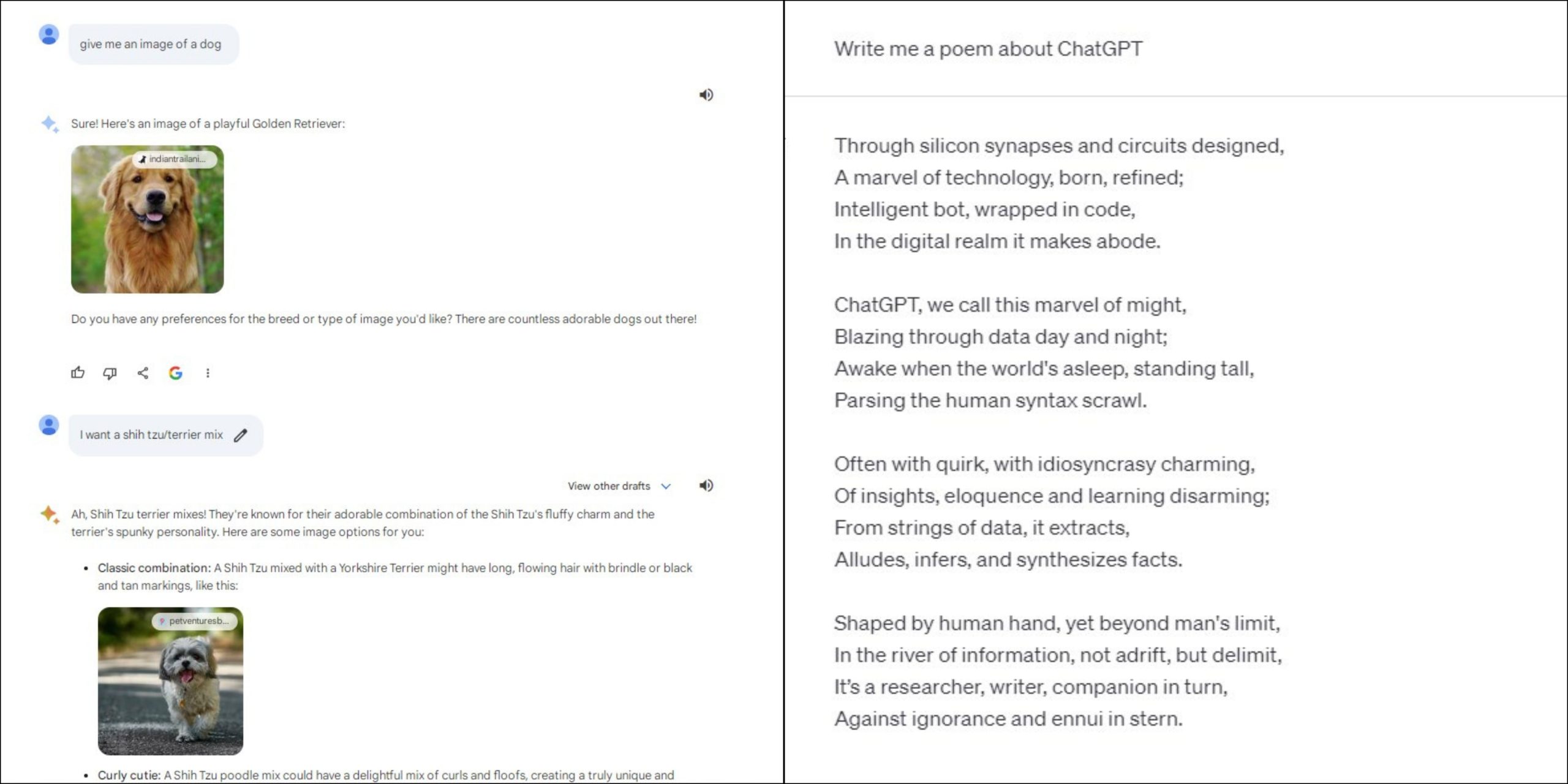ChatGPT versus Bard for creating content
Artificial Intelligence (AI) content writing has taken the digital world by storm, offering innovative solutions for businesses looking to streamline their content creation processes. While traditional writing is undeniably pivotal, adopting these AI tools, such as ChatGPT and Bard, has unarguably accelerated efficiencies in producing SEO-optimised content.
ChatGPT versus Bard
ChatGPT

Photo taken from Motiongraphicplus
ChatGPT is an advanced language model developed by OpenAI. Deploying machine learning capabilities, it is capable of generating human-like text, transmitting the nuances of conversational writing, and intuitively delivering effective SEO content.
It is a popular choice among businesses looking to automate their content creation, thus improving their AI content writing quality and SEO performance.
Bard

Photo taken from Freelogopng
Bard has left an indelible mark in the sphere of automated content creation. Its unique selling point is its user-friendly interface combined with specialized features designed with the needs of content creators in mind. Firstly, Bard places great importance on the readability and cohesion of the content created.
This attention to detail culminates in a valuable blend of superior quality and simplicity. It plays an essential role in harmonizing the AI-powered writing process with the objectives of SEO optimization.
| Feature | Bard | ChatGPT |
|---|---|---|
| Data source | Real-time access to internet information (current as of 2023-12-20) | Limited to data available up to 2021 |
| Strengths | Research and factual accuracy, citing sources, creative tasks like writing different content formats, integrating with Google apps | Generating open-ended creative text formats (poems, code, scripts), engaging in conversational dialogue (including voice) |
| Weaknesses | Can be overly cautious and avoid making bold claims, It is still under development with features being added | May struggle with factual accuracy and neutrality, prone to biases present in its training data |
| User interface | Simple and web-based | Mobile app available with voice chat capabilities |
| Integrations | Deep integration with Google apps like YouTube, Maps, and Lens | Wide range of third-party plugins available through ChatGPT Plus subscription |
| Accessibility | Free to use | Free tier with limited features, paid subscription for full access |
Keep in mind that both Bard and ChatGPT are constantly being updated and each may have more features than they do at the moment.
Which AI tool produces content better
Both ChatGPT and Bard provide a viable solution for businesses that are looking for a helping hand in their content. Although it is essential to understand during their comparison, there are differences when using each of these AI content creation tools to produce content.
Ease of use: The user-friendly faceoff
OpenAI’s ChatGPT is designed with a user-friendly interface that works well, especially for those who are just getting started in the world of AI. Its streamlined design allows it to provide concise and clear answers to queries. Moreover, it doesn’t require specialized technical knowledge or programming skills.
This makes it perfect for beginners who need a straightforward, easy-to-use tool. It’s like a digital companion that is ready to assist with responses that are quick and easy to comprehend.

LEFT: Bard Bot searching images about dogs | RIGHT: ChatGPT making a poem
On the other hand, Bard is also a relatively easy tool to use as well. It features a different user interface which provides some more features than ChatGPT. The user can also control and fine-tune the AI’s response to suit their needs as well. Furthermore, the Bard bot offers more features where you can share images and specify what you are looking for as well.
Bard will introduce a learning curve as there are certain complexities and technical aspects that could be challenging at first. However, this AI tool provides more flexibility and control for detailed and adaptable content output.
AI content writing quality: Creating perfect content
Regarding the standard of content produced by AI tools, both Bard and ChatGPT showcase considerable potential. ChatGPT can conjure meticulous, savvy content backed by its extensive and diverse training data set.
This means it has wide access to a plethora of data which informs its artificial intelligence, helping it to create in-depth outputs. Not only does the content produced seem knowledgeable, but it is also rich in detail, providing an engaging read.

Photo by Camille Orgel on Unsplash
However, Bard succeeds in gaining an advantage concerning the distinctiveness of its style. Remarkable in terms of quality, Bard’s work is distinguished by its unique storytelling tactics and regular linguistic patterns. Its narrative style can provide information that is easy to read and very engaging.
It feels more immersive because the reader is carried along with the text in an easy-to-read manner. Bard’s writing is particularly captivating to readers because of its style and grammatical coherence.
SEO skills
Search engine optimization (SEO) is indisputably a critical pillar in the ever-evolving ecosystem of digital content creation. Consequently, it becomes paramount to address the matter of deciding which. AI writing tool outshines the rest in improving SEO. While it is undeniable that ChatGPT features decent SEO integration, Bard shows superior capabilities.
Unquestionably, Bard provides consumers with a wider range of necessary tools. These consist of, but are not restricted to: tag development, strategic keyword placement, and accurate readability evaluations. With this set of tools, Bard has an unparalleled ability to optimise SEO. Therefore, it wouldn’t be incorrect to say that it is more comprehensive and effective; in fact, it appears to offer a more all-encompassing strategy for enhancing SEO performance.
AI text detection
Having text in your content that is detected as more human gives it more ability to rank higher on Google. With that, it is imperative to understand which tool will allow you to write more consistent human text for the content to be seen more.
ChatGPT, with its vast pre-2022 dataset, excels at churning out engaging, if sometimes formulaic, content. Its strength lies in its familiarity, mimicking well-established writing styles. However, its reliance on older information can lead to factual inaccuracies and a lack of fresh perspective. Detecting ChatGPT’s work often hinges on spotting repetitive sentence structures or outdated references.

Photo by Markus Winkler on Unsplash
Bard, on the other hand, leverages Google’s cutting-edge AI prowess, incorporating up-to-date information and a wider range of writing styles. Its ability to synthesize complex concepts and inject personal touches like humour or anecdotes makes its work feel more nuanced and human-like. However, Bard’s focus on originality can sometimes lead to unexpected turns of phrase or unconventional vocabulary, which could raise flags for AI detectors.
Ultimately, the human touch remains the gold standard for truly captivating content. Both ChatGPT and Bard offer valuable tools but they can tend to regurgitate duplicate information that can feel bland to readers. The human touch will ensure that the content feels fresh and flows well within its context.
The final verdict: striking the balance
Whether ChatGPT or Bard reigns supreme is reliant on the specific needs of the business. While both perform admirably within their niche, Bard appears to place a stronger emphasis on SEO optimisation tools, which might make it the frontrunner for businesses prioritising SEO.
Whichever tool one chooses, AI content writing brings transformative potential for businesses looking to enhance their digital performance. Often you will find that using a combination of both tools and the human touch may be necessary to produce the best content.

